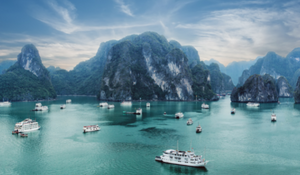“We have become dependent on China… We need to make supply chains more robust and diverse,...
Rising Tensions In The South China Sea
The South China Sea disputes have been a source of geopolitical tensions between Southeast Asia and its neighbour China and, to a lesser extent, among Southeast Asian nations as well.
The resource-rich area has been claimed by countries such as Brunei, China, Malaysia, Taiwan, the Philippines, and Vietnam. Indonesia has also become increasingly entangled in the disputes.
In this week’s article, we will be discussing the history behind the disputes, the countries’ territorial claims, the importance of the South China Sea, recent tensions and militarisation, and possible solutions to disputes.
Background
According to Chatham House, “[The] root of all these troubles is a line which was first printed on a Chinese map in 1948 looping around the South China Sea and stretching almost 1,500 kilometres from the Chinese coast on Hainan Island to areas just 50 kilometres off Malaysian Borneo and 100 kilometres off the Natuna Islands of Indonesia.”
These were the earliest modern Chinese claims to the South China Sea; however, recently, China stated the basis of Chinese claims also stem from historical trading routes that date back hundreds of years ago, writes Al-Jazeera. On the other hand, many Southeast Asian states’ claims are based on the 1982 United Nations Convention on the Law of the Sea (UNCLOS).
UNCLOS grants countries the right to include waters 200 miles from its coasts as part of its Exclusive Economic Zone. This legal principle also applies to archipelagic countries, such as the Philippines and Indonesia, with islands off the coast of the mainland. However, China’s historical claims are not protected by UNCLOS as ruled by the Permanent Court of Arbitration in 2016, reports the Guardian.
Territorial Claims
The following maps by the BBC and AFP, respectively, detail the territorial claims of the various claimant countries.
Importance of the South China Sea
Beyond the issue of territorial integrity, the South China Sea is a region of strategic importance. For China, it can serve as a means to project its influence beyond its immediate borders. Moreover, the South China Sea is incredibly resource rich. According to the Council on Foreign Relations, “[The sea has an] estimated 11 billion barrels of untapped oil and 190 trillion cubic feet of natural gas.”
Brunei, Indonesia, Malaysia, the Philippines, and Vietnam have sought to develop these natural resources, writes Chatham House. Time and time again, however, these countries have come under pressure from China to halt development. In fact, in 2020, Vietnam had to pay USD 1 billion to international energy firms having cancelled offshore energy contracts due to Chinese pressure.
Additionally, the South China Sea serves as a major shipping route as well as a major fishing route. The Brookings Institute and the Australian Strategic Policy Institute reports fishing vessels from various claimant nations have repeatedly crossed into other countries’ Exclusive Economic Zones in search of more bountiful catches.
Recent Tensions and Militarisation
The clear strategic importance of the South China Sea has consequently led to heightened militarisation. Al-Jazeera reports “China has ramped up its military presence in the region building artificial islands and air bases, where it has installed missile systems and other equipment… China’s so-called maritime militia has also been deployed, and stands accused of ‘harassing’ fishermen.”
Southeast Asian countries have also begun further militarisation. All claimant countries have stepped up the number of Coast Guard patrols and enhanced Coast Guard cooperation. At the same time, Indonesia started construction of a submarine base on the Natuna islands last year, according to Janes, in addition to the naval base it commissioned in 2018, according to the South China Morning Post.
Moreover, the US has stepped up activities in the region. The Council on Foreign Relations reports that between May and November, 2017, the US conducted six freedom of navigation patrols. It continues to do so while concurrently exploring various diplomatic avenues such as, for example, the Quadrilateral Security Dialogue and the Association of Southeast Asian Nations (ASEAN).
Possible Solutions
On the topic of ASEAN, ASEAN has been spearheading efforts to resolve the South China Sea disputes. ASEAN previously published the 2002 Declaration on the Conduct of Parties in the South China Sea, a non-legally binding document. It is currently in the process of negotiating a Code of Conduct for the South China Sea, a potentially legally binding document.
However, according to the East Asia Forum, negotiations have stalled. This is unsurprising, considering the 2002 Declaration took decades to complete. Nonetheless, as the only multilateral organisation composed of and led by the Southeast Asian claimant countries, it stands to reason ASEAN would continue to lead any effort to resolve the disputes. Though, time is running out.
Conclusion
The South China Sea disputes are evidently a very complex, dangerous, and continually evolving situation, directly involving six different countries and indirectly involving other regional powers.
Some claims to the South China Sea are rooted in international laws. Others less so. Regardless, it is clear that the South China Sea is a strategic region of great importance.
-1.jpg?width=146&height=50&name=Kusu%20(1)-1.jpg)




.png?height=200&name=Untitled%20design%20(28).png)